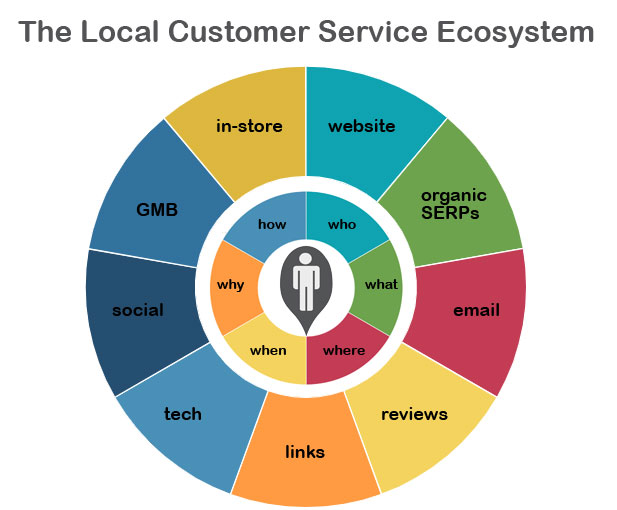What is local customer service in 2019? Your always-on customer service solves all of these problems with a combination of all of the following: Good customer service looks like: A publicly accessible brand policy that protects the rights and defends the dignity of both employees and consumers. Good customer service looks like: Content that solves people’s problems as conveniently and thoroughly as possible in language that they speak. Signals of benefit, including community involvement, philanthropy, environmental protections, etc. Management also includes monitoring of the SERPs for highly-ranked content that cites problems others are having with the brand. Good customer service looks like: Accessible email addresses for customers seeking support and fast responses to queries. Good customer service looks like: Brand accessibility on social platforms most favored by customers. Social monitoring of the brand name to identify and resolve complaints, as well as to acknowledge praise. Every single employee of every local brand in the US already knows what good customer service feels like, because all of us are customers. It’s a kind of love when you ensure a customer isn’t misdirected by a wrong address on a local business listing or when you answer a negative review with the will to make things right.

Everything your brand does in the new year should support just one goal: better local customer service.
Does this sound too simple? Doesn’t marketing brim with a thousand different tasks? Of course — but if the goal of each initiative isn’t to serve the customer better, it’s time for a change of business heart. By putting customers, and their problems, at the absolute center of your brand’s strategy, your enterprise will continuously return to this heart of the matter, this heart of commerce.
What is local customer service in 2019?
It’s so much more than the face-to-face interactions of one staffer with one shopper. Rather, it’s a commitment to becoming an always-on resource that is accessible to people whenever, wherever and however they need it. A Google rep was recently quoted as saying that 46% of searches have a local intent. Mobile search, combined with desktop and various forms of ambient search, have established the local web as man’s other best friend, the constant companion that’s ever ready to serve.
Let’s position your brand to become that faithful helper by establishing the local customer service ecosystem:

Your Key to the Local Customer Service Ecosystem
At the heart sits the local customer, who wants to know:
- Who can help them, who likes or dislikes a business, who’s behind a brand, who’s the best, cheapest, fastest, closest, etc.
- What the answer is to their question, what product/service solves their problems, what businesses are nearby, what it’s like there, what policies protect them, what’s the phone number, the website URL, the email address, etc.
- Where a business is located, where to find parking, where something is manufactured or grown, etc.
- When a business is open, when sales or events are, when busiest times are, when to purchase specific products/services or book an appointment, etc.
- Why a business is the best choice based on specific factors, why a business was founded, why people like/dislike a business, etc.
- How to get to the business by car/bike/on foot, how to learn/do/buy something, how to contact the right person or department, how to make a complaint or leave feedback, how the business supports the community, etc.
Your always-on customer service solves all of these problems with a combination of all of the following:
Good customer service looks like:
- A publicly accessible brand policy that protects the rights and defends the dignity of both employees and consumers.
- Well-trained phone staff with good language skills, equipped to answer FAQs and escalate problems they can’t solve. Sufficient staff to minimize hold-times.
- Well-trained consumer-facing staff, well-versed in policy, products and services. Sufficient staff to be easily-accessible by customers.
- In-store signage (including after-hours messaging) that guides consumers towards voicing complaints in person, reducing negative reviews.
- In-store signage/messaging that promotes aspects of the business that are most beneficial to the community. (philanthropy, environmental stewardship, etc.) to promote loyalty and word-of-mouth.
- Cleanliness, orderliness and fast resolution of broken fixtures and related issues.
- Equal access to all facilities with an emphasis on maximum consumer comfort and convenience.
- Support of payment forms most popular with local customers (cash, check, digital, etc.), security of payment processes, and minimization of billing mistakes/hassles.
- Correctly posted, consistent hours of operation, reducing inconvenience. Clear messaging regarding special hours/closures.
- A brand culture that rewards employees who wisely use their own initiative to solve customers’ problems.
Good customer service looks like:
- Content that solves people’s problems as conveniently and thoroughly as possible in language that they speak. Everything you publish (home, about, contact, local landing pages, etc.) should pass the test of consumer usefulness.
- Equal access to content, regardless of device.
- Easily accessible contact information, including name, address, phone number, fax, email, text, driving directions, maps and hours of operation.
- Signals of trustworthiness, such as reviews, licenses, accreditations, affiliations, and basic website security.
- Signals of benefit, including community involvement, philanthropy, environmental protections, etc.
- Click-to-call phone numbers.
- Clear policies that outline the rights of the consumer and the brand.
Good customer service looks like:
- Management of the first few pages of the organic SERPs to ensure that basic information on them is accurate. This includes structured citations on local business directories, unstructured citations on blog posts, news sites, top 10 lists, review sites, etc. It can also include featured snippets.
- Management also includes monitoring of the SERPs for highly-ranked content that cites problems others are having with the brand. If these problems can be addressed and resolved, the next step is outreach to the publisher to demonstrate that the problem has been addressed.
Good customer service looks like:
- Accessible email addresses for customers seeking support and fast responses to queries.
- Opt-in email marketing in the form of newsletters and special offers.
Good customer service looks like:
- Accuracy of basic business information on major review platforms.
- Professional and fast responses to both positive and negative reviews, with the core goal of helping and retaining customers by acknowledging their voices and solving their problems.
- Sentiment analysis of reviews by location to identify emerging problems at specific branches for troubleshooting and resolution.
- Monitoring of reviews for spam and reporting it where possible.
- Avoidance of any form of review spam on the part of the brand.
- Where allowed, guiding valued customers to leave reviews to let the greater community know about the existence and quality of your brand.
Good customer service looks like:
- Linking out to third-party resources of genuine use to customers.
- Pursuit of inbound links from relevant sites that expand customers’ picture of what’s available in the place they live, enriching their experience.
Good customer service looks like:
- Website usability and accessibility for users of all abilities and on all browsers and devices (ADA compliance, mobile-friendliness, load speed, architecture, etc.)
- Apps, tools and widgets that improve customers’ experience.
- Brand accessibility on social platforms most favored by customers.
- Analytics that provide insight without trespassing on customers’ comfort or right to privacy.
Good customer service looks like:
- Brand accessibility on social platforms most favored by customers.
- Social monitoring of the brand name to identify and resolve complaints, as well as to acknowledge praise.
- Participation for the sake of community involvement as opposed to exploitation. Sharing instead of selling.
- Advocacy for social platforms to improve their standards of transparency and their commitment to protections for consumers and brands.
Good customer service looks like:
- Embrace of all elements of Google’s local features (Google My Business listings, Knowledge Panels, Maps, etc.) that create convenience and accessibility for consumers.
- Ongoing monitoring for accuracy of…

COMMENTS